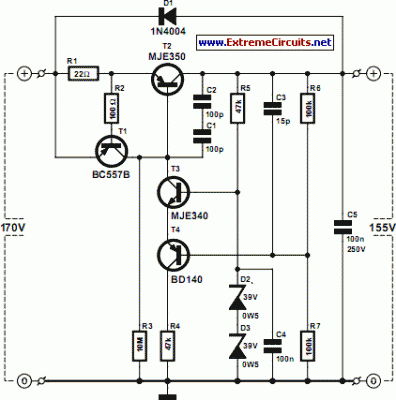- Stablised Power Supply With Short-Circuit Indication
- 3-30V 3A Adjustable Regulated DC Power Supply
- 9 Volt 2 Ampere DC Power Supply Circuit Diagram
- Adjustable 1.3-22V Regulated Power Supply
- Adjustable Current Limit For Dual Power Supply
- Quad Power Supply For Hybrid Amplifier
- Stabilized Regulated Power Supply Circuit
- Transformerless 5 Volt Power Supply
- Variable Dc Power Supply
- High-Voltage Regulator With Short Circuit Protection
- Ampere or Current Booster Circuit
- Smoke Alarm Battery Life Extender
- High Current Regulated Supply
- 2 Watt Switching Power Supply
- Variable Voltage and Current Power Supply
High-Voltage Regulator With Short Circuit Protection
Description
There are many circuits for low voltage regulators. For higher voltages, such as supplies for valve circuits, the situation is different. That’s why we decided to design this simple regulator that can cope with these voltages. This circuit is obviously well suited for use in combination with the quad power supply for the hybrid amp, published elsewhere in this issue. The actual regulator consists of just three transistors. A fourth has been added for the current limiting function.
The circuit is a positive series regulator, using a pnp transistor (T2) to keep the voltage drop as low as possible. The operation of the circuit is very straightforward. When the output voltage drops, T4 pulls the emitter of T3 lower. This drives T2 harder, which causes the output voltage to rise again. R4 restricts the base current of T2. C1 and C2 have been added to improve the stability of the circuit.
These are connected in series so that the voltage across each capacitor at switch-on or during a short circuit doesn’t become too large. You should use capacitors rated for at least 100 V for C1-C3. D1 protects T2 against negative voltages that may occur when the input is short-circuited or when large capacitors are connected to the output. We use two zener diodes of 39 V connected in series for the reference voltage, giving 78 V to the base of T3.
Because R6 is equal to R7 the output voltage will be twice as large, which is about 155 V. T4 acts as a buffer for potential divider R6/R7, which means we can use higher values for these resistors and that the voltage is not affected by the base current of T2 (this current is about the same as the emitter current of T3). This is obviously not a temperature compensated circuit, but for this purpose it is good enough.
Circuit diagram:
The current limiting section built around T1 couldn’t be simpler. When the output current rises above 30 mA the voltage across R1 causes T1 to conduct. T1 then limits the base-emitter voltage of T2. R2 is required to protect T1 against extremely fast peak voltages across R1. R3 is needed to start the regulator. Without R3 there wouldn’t be a voltage at the output and hence there wouldn’t be a base current in T2. R3 lets T2 conduct a little bit, which is sufficient for the regulator to reach its intended state.
During normal operation with a voltage drop of 15 V across T2 and a current of about 30 mA there is no need for extra cooling of T2. The junction temperature is then 70 °C, which means you can burn your fingers if you’re not careful! The lower the input voltage is, the more current can be supplied by this regulator. This current is determined by the SOAR (Safe Operation ARea) of T2. During a short circuit and an input voltage of 140 V the current is about 30 mA and T2 certainly requires a heatsink of at least 10 K/W in those conditions.
To increase the output voltage you should use a larger value for R6. If you want to use a higher reference voltage, you should replace T4 with a MJE350. If you only ever need to draw a few milli-amps there is no need to include T4 and R4. The potential divider (R6/R7) can then be connected directly to the emitter of T3. The ripple suppression of the circuit is about 50 dB. The quiescent current is 2.5 mA and for small currents the dropout voltage is only 1.5 V.
